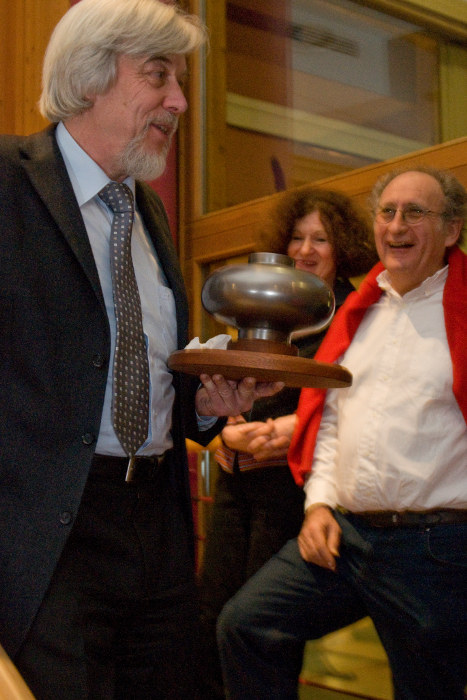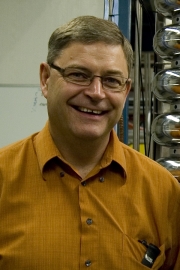Director's Corner
18 December 2008
A year in the life of the ILC
Today's issue features a Director's Corner from Nick Walker, Project Manager for the Global Design Effort.
By chance I find myself with the job of writing the last Director's Corner of 2008. The holiday season is now almost upon us – traditionally a time to be both retrospective and forward-looking, with people around the world putting last year behind them, while planning with new hope for the next. In keeping with this tradition, it seems appropriate to take a brief look back over a year which has certainly had its ups and downs.
It was almost one year ago exactly when it seemed that I was constantly on the telephone to my American and UK colleagues, as "Black December" (as Brian Foster later named it) descended upon us. The beginning of the year held many uncertainties as the consequences of the funding situation in those two countries slowly became apparent. But the solid basis of being a truly global collaboration prevailed: the Global Design Effort's quick reaction and re-planning in light of the events was credited and endorsed by FALC and the broader community alike. As the "Engineering Phase" became a "Technical Phase", it became clear that the mostly politically motivated funding cuts would not be the end of the ILC; nor did they initiate a 'domino effect' across the rest of the world as many had feared. The resilience of the global community and its sense of determination prevailed. As Barry put it, our science case has not changed – the one which we still believe is as compelling as it is exciting.
 The high-resolution surface inspection camera for superconducting cavities was developed in Japan and is now in use in all three regions. The high-resolution surface inspection camera for superconducting cavities was developed in Japan and is now in use in all three regions. |
Despite this year's cuts, we have seen technical progress virtually across the board. Our three main GDE meetings (at Tohoku University, Sendai, Japan, in March; JINR, Dubna, Russia, in June; and finally LCWS08/ILC08, Chicago, US in November) were all well attended and productive. The progress in the global SCRF development has been steady, with the investment in infrastructure as impressive as it is large. Highlights include some key breakthroughs in the high-gradient programme: in particular the development of the new optical inspection device by KEK and Kyoto University – a technology which has now been 'exported' to the other two regions. In addition, several Beam Test Facilities have come 'online' this year. CesrTA at Cornell offers unique facilities for electron-cloud work for the ILC damping rings (together with KEK-B and ATF in Japan, as well as DaΦne at INFN Frascati in Italy); the new ATF-2 beam test facility at KEK has now started commissioning, opening up an exciting programme for final-focus system and instrumentation-related R&D. Here at DESY we have TTF/FLASH – currently a unique SCRF beam test facility – where we continue towards routine demonstration of high-current operation. As well as being focused on critical risk-reduction R&D, these facilities will also serve and support our R&D community for the next years. Wherever we look we see vibrant and challenging programmes, which are fundamentally 'glued together' by the GDE and the ILC R&D plan.
Of course it would not be correct to only highlight the positive: the impact of 'Black December' has been felt. In the US, ILC-related activities have for the most part been on hold for the 2008 fiscal year. SLAC – a laboratory whose name is synonymous with the term "linear collider" – suffered most as budgets fell. Fermilab staff had to endure an effective pay cut across the board. In both labs many ILC-related activities stopped. Fortunately, as of 1 October, the money has begun to flow once more, and both SLAC and Fermilab and other US labs are committed to their important respective contributions to the global ILC effort. In the UK, a resilient community managed to maintain key ILC management role personnel despite a dire funding situation. As an international community, we owe it to ourselves to support in all ways possible these important institutions, if we are to achieve our common goals.
Closer to (my) home, a few additional noteworthy events have occurred. Last week at DESY, the formal contracts for the start of the civil construction for the European XFEL were signed, with work beginning in January. The XFEL and ILC are 'joined at the hip' by the common main linac technology, and the importance of the XFEL project to the GDE cannot be overstated. Next year orders will be placed for the more than 800 cavities, couplers, tuners, and cryostats required to construct the about 100 cryomodules needed for the 17.5-GeV linac. Beyond the strong technical synergy with the ILC, the XFEL is also a model for an international collaboration based on in-kind contributions. We will continue to work closely with our colleagues at DESY, CEA Saclay, LAL Orsay and INFN Milan as this exciting and unique project gets underway.
 Next CERN Director General Rolf Heuer admiring an ILC cavity during his dedicated colloquium at DESY this December. Photo: DESY Next CERN Director General Rolf Heuer admiring an ILC cavity during his dedicated colloquium at DESY this December. Photo: DESY |
Another emerging collaboration – namely that with CERN and CLIC – has often been reported on this year. The closer ties between the groups have been positively welcomed by committees and the press alike. We will actively pursue a closer working relationship with out CLIC colleagues over the next years – eventually becoming the 'one community' that we really are.
Finally, I'd like to take this opportunity for a personal note, and wish Rolf-Dieter Heuer all the best as he leaves DESY to take the reigns of CERN as the next Director-General. Rolf is well-known to the ILC community for his leadership role in the physics and detector community over the years. I was recently privileged to attend his leaving colloquium here at DESY, where by way of entertainment he received many subtle – and some not so subtle – reminders of his linear collider past. Of course, Rolf's immediate future and priority now is the LHC, the success of which is mandatory for any future collider project. I'm sure I speak for all of us in wishing him and CERN well with this critical and exciting project.
So that was the year that was. All that now remains is to wish you all – on behalf of the GDE Executive Committee – the best for the Holiday Season and the coming New Year. We look forward more than ever to working with you in the future on what still is our Great Adventure.
-- Nick Walker
